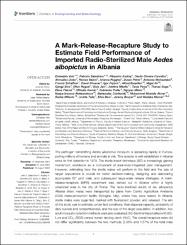| dc.contributor.author | Velo, Enkelejda | |
| dc.contributor.author | Balestrino, Fabrizio | |
| dc.contributor.author | Kadriaj, Perparim | |
| dc.contributor.author | Carvalho, Danilo Oliveira | |
| dc.contributor.author | Dicko, Ahmadou | |
| dc.contributor.author | Bellini, Romeo | |
| dc.contributor.author | Puggioli, Arianna | |
| dc.contributor.author | Petric, Dusan | |
| dc.contributor.author | Michaelakis, Antonios | |
| dc.contributor.author | Schaffner, Francis | |
| dc.contributor.author | Almenar, David | |
| dc.contributor.author | Pajovic, Igor | |
| dc.contributor.author | Beqirllari, Alfred | |
| dc.contributor.author | Ali, Migel | |
| dc.contributor.author | Sino, Gjergji | |
| dc.contributor.author | Rogozi, Elton | |
| dc.contributor.author | Jani, Vjola | |
| dc.contributor.author | Nikolla, Adelina | |
| dc.contributor.author | Porja, Tanja | |
| dc.contributor.author | Goga, Thanas | |
| dc.contributor.author | Falcua, Elena | |
| dc.contributor.author | Kavran, Mihaela | |
| dc.contributor.author | Pudar, Dubravka | |
| dc.contributor.author | Mikov, Ognyan | |
| dc.contributor.author | Ivanova-Aleksandrova, Nadya | |
| dc.contributor.author | Cvetkovikj, Aleksandar | |
| dc.contributor.author | Akıner, Muhammet Mustafa | |
| dc.contributor.author | Mikovic, Rados | |
| dc.contributor.author | Tafaj, Lindita | |
| dc.contributor.author | Bino, Silva | |
| dc.contributor.author | Bouyer, Jeremy | |
| dc.contributor.author | Mamai, Wadaka | |
| dc.date.accessioned | 2022-11-27T18:09:34Z | |
| dc.date.available | 2022-11-27T18:09:34Z | |
| dc.date.issued | 2022 | en_US |
| dc.identifier.citation | Velo, E., Balestrino, F., Kadriaj, P., Carvalho, D. O., Dicko, A., Bellini, R., Puggioli, A., Petrić, D., Michaelakis, A., Schaffner, F., Almenar, D., Pajovic, I., Beqirllari, A., Ali, M., Sino, G., Rogozi, E., Jani, V., Nikolla, A., Porja, T., Goga, T., … Mamai, W. (2022). A Mark-Release-Recapture Study to Estimate Field Performance of Imported Radio-Sterilized Male Aedes albopictus in Albania. Frontiers in bioengineering and biotechnology, 10, 833698. https://doi.org/10.3389/fbioe.2022.833698 | en_US |
| dc.identifier.issn | 2296-4185 | |
| dc.identifier.uri | https://doi.org/10.3389/fbioe.2022.833698 | |
| dc.identifier.uri | https://hdl.handle.net/11436/7169 | |
| dc.description.abstract | The pathogen transmitting Aedes albopictus mosquito is spreading rapidly in Europe, putting millions of humans and animals at risk. This species is well-established in Albania since its first detection in 1979. The sterile insect technique (SIT) is increasingly gaining momentum worldwide as a component of area-wide-integrated pest management. However, estimating how the sterile males will perform in the field and the size of target populations is crucial for better decision-making, designing and elaborating appropriate SIT pilot trials, and subsequent large-scale release strategies. A mark-release-recapture (MRR) experiment was carried out in Albania within a highly urbanized area in the city of Tirana. The radio-sterilized adults of Ae. albopictus Albania strain males were transported by plane from Centro Agricoltura Ambiente (CAA) mass-production facility (Bologna, Italy), where they were reared. In Albania, sterile males were sugar-fed, marked with fluorescent powder, and released. The aim of this study was to estimate, under field conditions, their dispersal capacity, probability of daily survival and competitiveness, and the size of the target population. In addition, two adult mosquito collection methods were also evaluated: BG-Sentinel traps baited with BG-Lure and CO2, (BGS) versus human landing catch (HLC). The overall recapture rates did not differ significantly between the two methods (2.36% and 1.57% of the total male released were recaptured respectively by BGS and HLC), suggesting a similar trapping efficiency under these conditions. Sterile males traveled a mean distance of 93.85 +/- 42.58 m and dispersed up to 258 m. Moreover, they were observed living in the field up to 15 days after release with an average life expectancy of 4.26 +/- 0.80 days. Whether mosquitoes were marked with green, blue, yellow, or pink, released at 3.00 p.m. or 6.00 p.m., there was no significant difference in the recapture, dispersal, and survival rates in the field. The Fried competitiveness index was estimated at 0.28. This mark-release-recapture study provided important data for better decision-making and planning before moving to pilot SIT trials in Albania. Moreover, it also showed that both BG-traps and HLC were successful in monitoring adult mosquitoes and provided similar estimations of the main entomological parameters needed. | en_US |
| dc.language.iso | ara | en_US |
| dc.publisher | Frontiers Media | en_US |
| dc.rights | info:eu-repo/semantics/openAccess | en_US |
| dc.subject | Mosquitoes | en_US |
| dc.subject | Pest | en_US |
| dc.subject | Management | en_US |
| dc.subject | Survival | en_US |
| dc.subject | Dispersal | en_US |
| dc.subject | Competitiveness | en_US |
| dc.subject | BG sentinel trap | en_US |
| dc.subject | Sterile Insect Technique | en_US |
| dc.title | A mark-release-recapture study to estimate field performance of imported radio-sterilized male aedes albopictus in Albania | en_US |
| dc.type | article | en_US |
| dc.contributor.department | RTEÜ, Fen - Edebiyat Fakültesi, Biyoloji Bölümü | en_US |
| dc.contributor.institutionauthor | Akıner, Muhammet Mustafa | |
| dc.identifier.doi | 10.3389/fbioe.2022.833698 | en_US |
| dc.identifier.volume | 10 | en_US |
| dc.identifier.startpage | 833698 | en_US |
| dc.relation.journal | Frontiers in Bioengineering and Biotechnology | en_US |
| dc.relation.publicationcategory | Makale - Uluslararası Hakemli Dergi - Kurum Öğretim Elemanı | en_US |


















